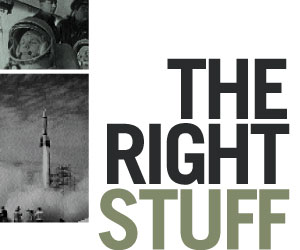
Once upon a time, when Bob Challey was 12 years old, the Russians launched a dog named Laika into space. In 1957, it was the stuff of little boys' dreams - a rocket, a pooch and a star-specked sky.
About the time Challey entered Fargo's Ben Franklin Junior High, cosmonaut Yri Gagarin completed the first manned space flight. In 1963, when Challey graduated from Fargo Central High School, Valentian Tereshkov became the first woman in space. And in the midst of Challey's chemistry studies at North Dakota State University, Alexei Leonov walked in space. In 1969, when Appollo 11 astronauts walked on the moon, Challey was a graduate student at the University of California-Berkley, working on a NASA-funded project. The leader of Challey's research group was a would-be-Nobel-Prize-winner-wanna-be-astronaut. The professor accomplished neither, but he did have a research instrument on Mariner-6 designed to gather data on the Martian atmosphere. As a research assistant, it was Challey's job to analyze that data. Challey enjoyed the project due to its practical nature and his long-time interest in space exploration.
After completing his master's, Challey stayed in California and started collecting buildings. He's been in real estate ever since. As an owner, investor and manager based in Walnut Creek, he has interests throughout California and Washington. Apartments mostly. Some commercial and office buildings.

"A BUNCH OF ASTRONAUTS AND THEIR FAMILIES WERE TRYING TO MAKE ENOUGH MONEY TO LIVE, BASICALLY, WHICH IS KIND OF SAD. THE GOVERNMENT HAD ALLOWED THEM TO DO THIS AND EVEN CONTRIBUTED SOME OF ITS ARTIFACTS, BECAUSE IT WAS STRAPPED FOR MONEY. ... THE CATALOG ITSELF HAS PAGES AND PAGES OF SPACE HISTORY. IT'S ALMOST A TEXTBOOK ON THE RUSSIAN SPACE EFFORT."
"My wife says I collect everything," Challey said in a telephone interview from their summer home in Lake Tahoe. He can't even name all his collections: wine, art, trading cards (he started with airplane cards at age 7).
"Along the way, in the early '90s, I'd been buying stuff through Christie's and Sotheby's and word got out that there was going to be sale of Russian space artifacts," Challey said. "A bunch of astronauts and their families were trying to make enough money to live, basically, which is kind of sad. The government had allowed them to do this and even contributed some of its artifacts, because it was strapped for money. ... The catalog itself has pages and pages of space history. It's almost a textbook on the Russian space effort."
Challey jokes that his wife, Sheila, wouldn't let him bid on the 5-ton spacecraft, but he was determined to purchase something significant, and he did, both in this auction and one that took place a few years later.
He procured a food packet from the world's first manned space flight, provided by Gagarin's family. He also got autographed pictures, a letter describing the space flight, a duffel bag of clothing, mission patches and other smaller items. Challey's top bid also brought him the high-altitude flight suit Leonov wore on the trip home from the first space walk. With lacings that run up the sleeves, along the inner and outer leg seams and up the chest, it looks like a costume from a sci-fi movie. But this is the genuine article; Leonov autographed it before he sold it.
Challey delights in telling stories of the astronauts, especially harrowing spacecraft landings in Siberia, where Russian cosmonauts braved hazardous conditions to hide their missions from American view. One of Leonov's many flights nearly ended in disaster when he crawled out of his spacecraft and was attacked by a bear. Leonov survived, but Challey said that afterward Russian scientists created a new multi-purpose piece of gear that could function like a shotgun.
Some years passed and Challey realized he didn't have the place to properly store, much less display, his Russian space collection. When he heard Warren Diederich, a fellow member of the NDSU Development Foundation Board of Trustees, was opening an air museum in Fargo, it gave him an idea. Perhaps Diederich would care for these treasures and share them with the public. After all, the Smithsonian had been interested.
So was Diederich.
And that is how the Fargo Air Museum got Challey's Russian space collection. And while it's unlikely an auction will ever again be devoted entirely to Russian space memorabilia, Challey - ever the collector - said, "If something came up again, I'd buy it and ship it to Fargo."
-Catherne Jelsing

































